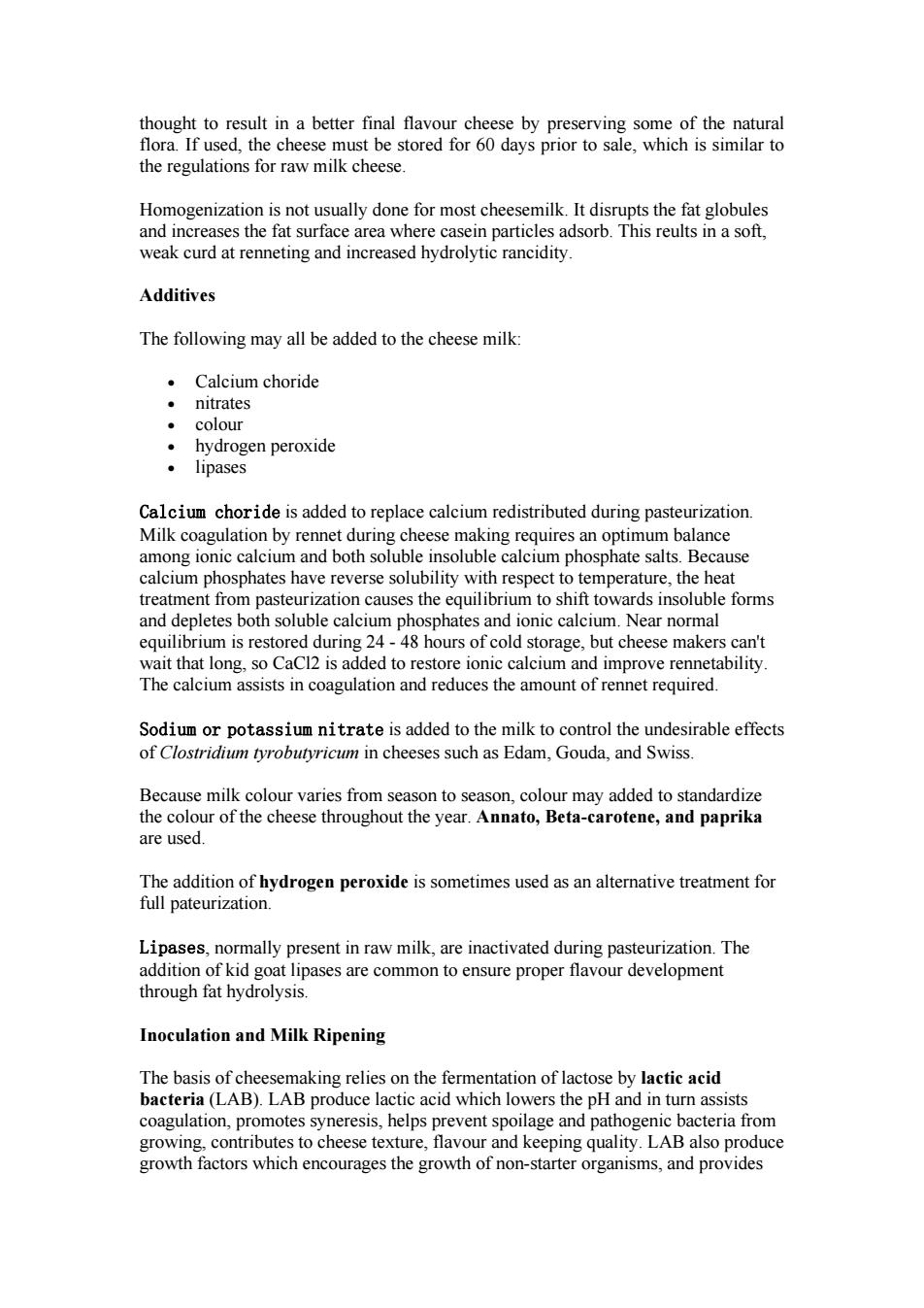正在加载图片...

thought to result in a better final flavour cheese by preserving some of the natural flora.If used,the cheese must be stored for 60 days prior to sale,which is similar to the regulations for raw milk cheese. Homogenization is not usually done for most cheesemilk.It disrupts the fat globules and increases the fat surface area where casein particles adsorb.This reults in a soft, weak curd at renneting and increased hydrolytic rancidity Additives The following may all be added to the cheese milk 。Calcium choride 。nitrates ·colour ·hydrogen peroxide 。lipases Calcium choride is added to replace calcium redistributed during pasteurization Milk coagulation by rennet during cheese making requires an optimum balance among ionic calcium and both soluble insoluble calcium phosphate salts.Because calcium phosphates have reverse solubility with respect to temperature,the heat treatment from pasteurization causes the equilibrium to shift towards insoluble forms and depletes both soluble calcium phosphates and ionic calcium.Near normal equilibrium is restored during 24-48 hours of cold storage,but cheese makers can't Sodium or potassium nitrate is added to the milk to control the undesirable effects of Clostridium tyrobutyricum in cheeses such as Edam,Gouda,and Swiss r vari es Iro sea colo may added to andardiz are us ed Annato,Beta-carotene,and paprika The addition of hydrogen peroxide is sometimes used as an alternative treatment for full pateurization. Lipases,normally present in raw milk,are inactivated during pasteurization.The addition of kid 3t1 pases are common to o ensure proper flavour dev Inoculation and Milk Ripening The basis of cheesemaking relies on the fermentation of lactose by lactic acid bacteria(LAB).LAB produce lactic acid which lowers the pH and in turn assists coagulation,promotes syneresis,helps prevent spoilage and pathogenic bacteria from growing.contributes to cheese texture,flavour and keeping quality.LAB also produce growth factors which encourages the growth of non-starter organisms,and provides thought to result in a better final flavour cheese by preserving some of the natural flora. If used, the cheese must be stored for 60 days prior to sale, which is similar to the regulations for raw milk cheese. Homogenization is not usually done for most cheesemilk. It disrupts the fat globules and increases the fat surface area where casein particles adsorb. This reults in a soft, weak curd at renneting and increased hydrolytic rancidity. Additives The following may all be added to the cheese milk: • Calcium choride • nitrates • colour • hydrogen peroxide • lipases Calcium choride is added to replace calcium redistributed during pasteurization. Milk coagulation by rennet during cheese making requires an optimum balance among ionic calcium and both soluble insoluble calcium phosphate salts. Because calcium phosphates have reverse solubility with respect to temperature, the heat treatment from pasteurization causes the equilibrium to shift towards insoluble forms and depletes both soluble calcium phosphates and ionic calcium. Near normal equilibrium is restored during 24 - 48 hours of cold storage, but cheese makers can't wait that long, so CaCl2 is added to restore ionic calcium and improve rennetability. The calcium assists in coagulation and reduces the amount of rennet required. Sodium or potassium nitrate is added to the milk to control the undesirable effects of Clostridium tyrobutyricum in cheeses such as Edam, Gouda, and Swiss. Because milk colour varies from season to season, colour may added to standardize the colour of the cheese throughout the year. Annato, Beta-carotene, and paprika are used. The addition of hydrogen peroxide is sometimes used as an alternative treatment for full pateurization. Lipases, normally present in raw milk, are inactivated during pasteurization. The addition of kid goat lipases are common to ensure proper flavour development through fat hydrolysis. Inoculation and Milk Ripening The basis of cheesemaking relies on the fermentation of lactose by lactic acid bacteria (LAB). LAB produce lactic acid which lowers the pH and in turn assists coagulation, promotes syneresis, helps prevent spoilage and pathogenic bacteria from growing, contributes to cheese texture, flavour and keeping quality. LAB also produce growth factors which encourages the growth of non-starter organisms, and provides